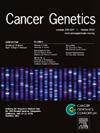pVACsplice:预测和优先选择替代剪接新抗原的计算工具
IF 1.4
4区 医学
Q4 GENETICS & HEREDITY
引用次数: 0
摘要
剪接新抗原是肿瘤特异性免疫疗法靶点的丰富来源,但尚未得到充分开发。与正常组织相比,肿瘤表现出更多的剪接错误,进而产生编码新肽的多种异构体。虽然编码区体细胞单点突变产生的新抗原已成为癌症疗法的广泛靶点,但包括替代剪接新抗原在内的其他新抗原来源还没有得到同等程度的关注。在这里,我们开发了 pVACsplice,这是一种预测顺式剪接相关新抗原候选物并对其进行优先排序的工具。pVACsplice 将替代转录本作为输入,将其转化为改变的肽,然后构建用户定义大小的新抗原。然后,它估算新表位与用户输入的 MHC 等位基因的结合亲和力,并根据各种标准(结合亲和力、溶解度、转录本质量等)对候选基因进行优先排序。然后,我们利用 pVACsplice 探索了小细胞肺癌(SCLC)队列中的剪接新抗原图谱。我们发现许多新连接和新抗原候选基因与这种恶性肿瘤中经常突变的基因有关。本文章由计算机程序翻译,如有差异,请以英文原文为准。
32. pVACsplice: A Computational tool for predicting and prioritizing alternative splicing neoantigens
Splicing neoantigens represent a rich yet underexplored source of tumor-specific targets for immunotherapy. Tumors exhibit increased mis-splicing events compared to normal tissues, which in turn create diverse isoforms that encode novel peptides. These peptides, especially ones derived from frameshifts, are highly distinct from self-antigens, hence presenting an opportunity for enhanced immune recognition.
Though neoantigens arising from somatic single-point mutations in coding regions have been widely targeted by cancer therapies, other neoantigen sources, including alternative splicing neoantigens haven't received the same amount of attention. Here, we develop pVACsplice, a tool that predicts and prioritizes cis-splicing associated neoantigen candidates. pVACsplice takes alternative transcripts as input, translates them into altered peptides, then constructs neoantigens of user-defined sizes. It then estimates binding affinities of neoepitopes with user-input MHC alleles, and prioritizes candidates based on various criteria (binding affinity, solubility, transcript quality, and more).
We then utilize pVACsplice to explore the splicing neoantigen landscape of a Small Cell Lung Cancer (SCLC) cohort. We find numerous neojunctions and neoantigen candidates associated with genes frequently mutated in this malignancy.
求助全文
通过发布文献求助,成功后即可免费获取论文全文。
去求助
来源期刊

Cancer Genetics
ONCOLOGY-GENETICS & HEREDITY
CiteScore
3.20
自引率
5.30%
发文量
167
审稿时长
27 days
期刊介绍:
The aim of Cancer Genetics is to publish high quality scientific papers on the cellular, genetic and molecular aspects of cancer, including cancer predisposition and clinical diagnostic applications. Specific areas of interest include descriptions of new chromosomal, molecular or epigenetic alterations in benign and malignant diseases; novel laboratory approaches for identification and characterization of chromosomal rearrangements or genomic alterations in cancer cells; correlation of genetic changes with pathology and clinical presentation; and the molecular genetics of cancer predisposition. To reach a basic science and clinical multidisciplinary audience, we welcome original full-length articles, reviews, meeting summaries, brief reports, and letters to the editor.
 求助内容:
求助内容: 应助结果提醒方式:
应助结果提醒方式:


